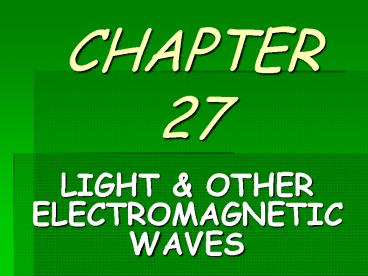LIGHT - PowerPoint PPT Presentation
Title:
LIGHT
Description:
CHAPTER 27 LIGHT & OTHER ELECTROMAGNETIC WAVES GAMMA RAYS Have the highest frequency and are the most penetrating. Gamma rays are emitted from the nuclei of ... – PowerPoint PPT presentation
Number of Views:87
Avg rating:3.0/5.0
Title: LIGHT
1
CHAPTER 27
- LIGHT OTHER ELECTROMAGNETIC WAVES
2
- Electromagnetic Waves
- are transverse waves produced by the motion of
electrically charged particles. - An electromagnetic wave consists of electric
field and magnetic field waves at right angles to
each other.
3
- Electromagnetic Waves
- These waves vary depending on frequency and
wavelength. - They dont need a medium to travel.
4
- Electromagnetic Waves
- Their speed varies with the change in medium.
- All electromagnetic waves travel at the same
speed through a vacuum (3 x 108 m/s). Their
wavelength and frequency are different.
5
- Electromagnetic Waves
- They carry energy and have momentum.
- They have both wave and particle like behavior.
6
(No Transcript)
7
(No Transcript)
8
(No Transcript)
9
(No Transcript)
10
- RADIO WAVES
- MICROWAVES
- INFRARED
- VISIBLE LIGHT
- ULTRA VIOLET LIGHT
- X-RAYS
- GAMMA RAYS
FREQUENCY INCREASES
WAVELENGTH DECREASES
ENERGY INCREASES
11
LIGHT
- Light is composed of tiny particles.
- These particle-like bundles of radiation are
called photons.
12
LIGHT
- Higher the frequency of the electromagnetic
waves, the greater the energy of the wave. - Light produces interference patterns like water
waves.
13
- RADIO WAVES
- Have low frequency
- and long wavelengths.
- They have the lowest
- photon energy.
14
- RADIO WAVES
- Radio waves are used to transmit radio and TV
signals. - They are also used in cellular phones and
cordless phones.
15
- RADIO WAVES
- The process of varying radio waves is called
modulation. - Voice, light images, computer information, and
music can be used - for modulation.
16
OTHER USES OF RADIO WAVES
- Communications
- Navigation and defense equipment
- Weather Forecasting
- 4.TV signals
- 5. AM and FM radio signals
- 6. Airport air traffic controllers
- 7. Radar used by police cars
17
INFRA RED RADIATION
- Has a wavelength slightly longer than visible
light. - Your skin feels warm
- outside because your
- skin is absorbing
- infrared radiation
- from the sun.
18
- A thermogram is produced by measuring the
infrared radiation given off by different parts
of the body. - Tumors are detected by thermograms because they
are warmer than other parts of the body.
19
- Some security systems are designed to detect
objects giving off infra red radiation and to
respond by activating an alarm.
20
- Infrared radiation are used to warm and dry
objects. - Infra red lamps in
- some restaurants
- keep the food
- warm until served.
21
- Infrared images obtained from sensors on
airplanes can yield important information on the
health of crops and help us see - forest fires even
- enveloped in an
- opaque layer of
- smoke.
22
Increasing Wavelength Decreasing Frequency
23
VISIBLE LIGHT
24
VISIBLE LIGHT
- It is the only part of the electromagnetic
spectrum that we can see. - Violet Color has a smaller wavelength than red
color.
25
ULTRA VIOLET RADIATION
- They have higher frequency than visible light.
- Exposure to UV radiation enables skin cell to
manufacture vitamin D, which is needed for
healthy bones and teeth.
26
ULTRA VIOLET RADIATION
- Ultra violet lamps are used in hospitals to kill
bacteria and viruses, and to sterilize surgical
instruments.
27
ULTRA VIOLET RADIATION
- UV rays are used to kill microorganisms in food
and on hospital equipment. - Some minerals like fluorite and scheelite become
fluorescent when exposed to UV light.
Fluorescence occurs when a material absorbs UV
radiation and re-emits visible light.
28
EXCESS OF ULTRA VIOLET RADIATION
- Lead to sagging, dry skin and even skin cancer.
Sunscreen contains chemicals that absorb UV
radiation before they penetrate your skin.
29
Crest
- Ozone is found in the Earths outer atmosphere
and it protects us from most of the suns UV
radiation.
30
Ozone is produced naturally through
photochemical reactions and electric discharge
reactions (lightning) in the atmosphere.
31
- Ozone depletion is caused by chemicals (CFC)
that break down ozone. These chemicals are found
in hair sprays, refrigerants etc.
32
X-RAYS
- X-rays have shorter wavelength and
- higher frequency
- than UV radiation.
- They possess enough energy to penetrate dense
objects like skin and muscles.
33
X-RAYS
- When X-rays hit more dense objects they are
absorbed. - X-rays are used to scan luggage and packages
without opening - them at the
- airport.
34
GAMMA RAYS
- Have the highest frequency and are the most
penetrating. - Gamma rays are
- emitted
- from the nuclei of
- radioactive atoms.
35
GAMMA RAYS
- Earth receives some gamma rays from space.
- They can be used to kill cancerous cells.
36
GAMMA RAYS
- People using gamma radiation for treatment suffer
side affects like nausea, hair loss, and fatigue
because healthy cells are also damaged.
37
THINK ABOUT IT
- 1.Describe at least two ways in which
electromagnetic waves differ from mechanical
waves. - 2.Describe at least one helpful use for each of
the six main types of electromagnetic radiation.































